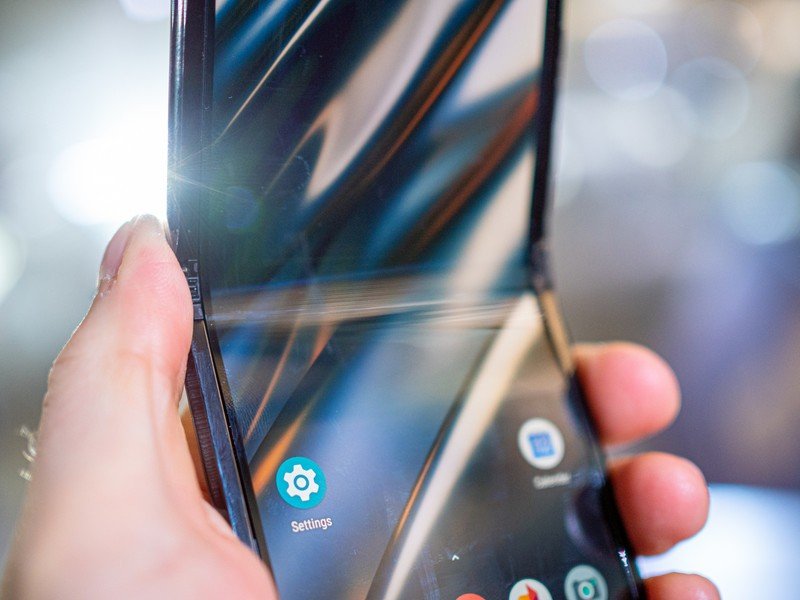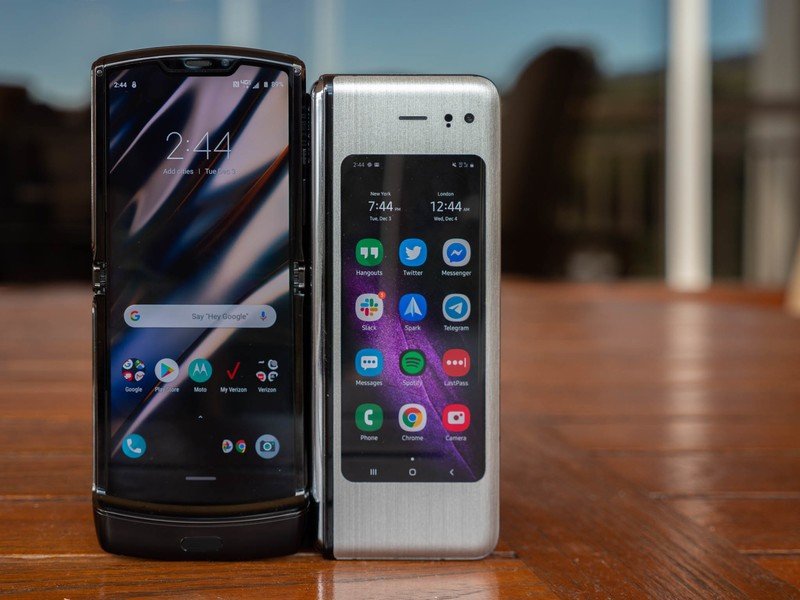Android Central Verdict
Bottom line: The Motorola RAZR is one of the best looking smartphones on the market. It excites like no other phone. However, look beyond the surface and you'll realize the compromises include average battery life, a creaking display and a lower than average camera. Ultimately, the compromises are too many for far too much money.
Pros
- +
Outstanding design
- +
Packs the WOW factor
- +
Great packaging
- +
Clean software experience
- +
Front Peek Display is useful
Cons
- -
Poor battery life
- -
Camera is disappointing
- -
No wireless charging
- -
Extremely expensive
- -
Concerns about display longevity
Why you can trust Android Central
This is the hardest review I've ever written. We're at the beginning of the foldable era, and we've already seen one foldable go through some questionable times, although Samsung was able to rectify the issues with the Galaxy Fold.
When Motorola revealed the 2020 RAZR back in November, the world — along with I — stood up and took notice. Motorola was back, challenging at the top of the industry and bringing back the legends in a big way.
It's hard to emphasise just how much interest there has been in the RAZR; Motorola itself pushed back the launch as they couldn't make enough to meet the demand, and even now shipping dates are several weeks out. The first question everyone asks when they see my Galaxy Fold is whether it's the new RAZR.
The Motorola RAZR is probably the most anticipated Motorola phone in a long time. It's a shame then that the compromises are large, the price is too high and ultimately, it's fell short of my expectations.
Motorola RAZR packs the wow factor
There's no other way to put it: the Motorola RAZR is the best designed phone on the market right now. To make a phone that is super thin when unfolded and keep the essence of the original RAZR is no mean feat.
When I've been using the RAZR out in public, more than one person has stopped me to ask about it. It garners attention easily, and goes some ways to explain why it's captured the imagination of people around the world.
Since I first laid eyes on the RAZR, I've loved it. It's so small when folded, it's almost like having a modern pager. Except, instead of a small non-interactive screen, you have the Peek Display which lets you sort through notifications at a glance. The buttons on the right hand side are small — making them hard to press — which adds to the feeling of a tool for filtering information, rather than actively communicating.
There's a particularly satisfying feeling to slamming the RAZR shut after a nuisance call.
When you do want to dive into a notification, you simply flip it open. If there's a call coming in, this can automatically answer the call, and like the original RAZR, you can also flip it shut to end a call. There's a particularly satisfying feeling when you do this after a spam call, although the deep integration of Google features and number lookups mean it often identifies them as spam before you answer the call.
If your notification is more of the traditional kind, the actions you can take are in line with those you'd find on a smartwatch. Depending on the app, you can use quickly triage by archiving and marking as read, or reply using canned responses or your voice. Unfortunately, this only works in some apps, and unlike the Galaxy Fold, if you're reading a notification and open the display, it won't take you straight to that app.

The majority of the technology in the RAZR is packed into the base, i.e. the bottom part of the phone that you hold in your hand. This means the RAZR is very bottom heavy and runs a lot warmer than the top half, which stays mostly cool even during intensive gaming. The bottom part can get really warm, but not hot enough for it to be a concern.
The back of the RAZR is quite slippery, and while the phone is the perfect width, it's a little too tall when unfolded. I've got large hands, and even I struggle with the gymnastics required to reach the top of the screen when using it one-handed. You'll definitely want a case; on more than one occasion, I've almost dropped it and it's only a matter of time until I do drop it.
The Motorola RAZR display is both good and bad

Should you drop it, I have my doubts that the display would be able to survive more than a light impact. Out of the box, the hinge — which is rumored to be made from plastic — made a light creaking sound just as you started folding the screen. After six days of use, the phone now makes an audible creaking sound as you're opening or closing the screen and a recent test revealed it may stop folding properly after just 28,000 folds. If that single test is indicative, that means the hinge and folding experience will last between nine and twelve months, and even though the screen worked fine after that test, this is a concerning possibility.
While they feature different designs, my Galaxy Fold barely makes a sound after two months of using it as my main phone. The Galaxy Fold set an expectation for me around the display in terms of durability and usability, and the Motorola RAZR falls short of that mark.
A bunch of people are receiving their #MotorolaRAZR tomorrow. I've been using it for five days - here's how the display is holding up in terms of creaking.
What do you think? Is this acceptable from a $1500 phone.after five days?
Tweet quoted is the display after one day. https://t.co/D9Tv7DHyF3 pic.twitter.com/6oQFhaRchEA bunch of people are receiving their #MotorolaRAZR tomorrow. I've been using it for five days - here's how the display is holding up in terms of creaking.
What do you think? Is this acceptable from a $1500 phone.after five days?
Tweet quoted is the display after one day. https://t.co/D9Tv7DHyF3 pic.twitter.com/6oQFhaRchE— Nirave 尼拉夫 (@nirave) February 6, 2020February 6, 2020
Motorola recently said bumps and lumps in the screen are normal, and while they're not really visible, you can definitely feel them when running your finger over the display. Especially in gaming, it's somewhat similar to the difference you feel when you have a small bubble in a screen protector. It hasn't impacted the experience of using the display yet, but after just a few days, it gives me huge cause for concern.
I have long-term concerns about the durability of the Motorola RAZR display.
Beyond the flexible nature, the rest of the screen is similar to that of previous Motorola smartphones. It lacks the punchiness or peak brightness of a Samsung phone, and opts for a more neutral profile vs vividly displaying colors like other displays. Outdoor visibility is below-average, and while there were a few issues with ghosting at first, these seem to have been resolved.
Of course, if it's just for notifications, you likely won't need to use the main display thanks to the small grayscale Peek Display on the front. It's grown on me as a way of triaging notifications, and I like how it displays a lot of caller information — such as business name or whether it's a spam call — when an unknown number calls you.
Hmm gotta admit this Peek Display does seem useful #MotorolaRAZR pic.twitter.com/OpZKyM3oilHmm gotta admit this Peek Display does seem useful #MotorolaRAZR pic.twitter.com/OpZKyM3oil— Nirave 尼拉夫 (@nirave) February 2, 2020February 2, 2020
To view a notification, you simply press and hold the icon at the bottom of the Peek Display. From here you can take several actions, which depend on the app. Unfortunately, I've found that it's far too easy to accidentally swipe away a notification, especially when trying to scroll through the panes of icons on the front display.
As useful as the Peek Display is, I wish it could do more. The huge battery life difference between using the front and main display means more functionality in the Peek Display could lead to a better overall battery experience (more on that below).
The Motorola RAZR battery is a disappointment

The Motorola RAZR features two batteries, which Motorola claims make up a total capacity of 2510mAh. A recent teardown on YouTube revealed a slightly lower capacity at 2380mAh but regardless of which is accurate, there's no denying physics and a smaller battery capacity means less battery life.



Source: Nirave Gondhia / Android Central
One of my biggest concerns when buying the RAZR was the battery life. I need a phone to last me at least a full day of usage, including hours of usage as my navigation, communication and entertainment tool. Battery sizes above 3500mAh or even 4000mAh have become the norm for the devices I use, and I can usually eke out more than a day of usage including at least six hours of screen-on-time.
The battery life is on par with the Pixel 4, which means it's not very good.
The Motorola RAZR fails to live up these expectations. During the course of the past week, I've found it lasts for an average of 12 to 14 hours on a single charge, especially when I'm relying on mobile data, which uses the eSIM in the phone on Verizon's network. This period of usage usually results in around 4 hours of screen-on-time. This battery life is on par with the Pixel 4, which is to say it's not very good.
Of course, it depends how you use the phone, and what your expectations are. When I prioritize scrolling notifications etc via the Peek Display — which generally remains on — I can get 7 hours of screen-on-time with a full day of usage. But if you primarily use the main display — which is likely given the limited functionality of the Peek Display — this drops considerably.



Source: Nirave Gondhia / Android CentralUsing the Peek Display results in drastically better battery life.
The RAZR does ship with an 18W TurboPower charger, meaning you can top up the battery pretty quickly. It takes around 90 minutes to charge the Motorola RAZR, which actually isn't that fast considering the smaller battery size but this charging speed is likely regulated to keep the phone from overheating during charging.
Ultimately, the Motorola RAZR battery size means it has a lower potential maximum battery life compared to other phones, regardless of how you use it. If you're willing to compromise and can access a charger throughout the day, it may be perfectly fine for you. However, for me, the battery isn't good enough that I would want to rely on the RAZR in an emergency.
Find out more in our Motorola RAZR battery review
The RAZR Camera just isn't good enough

I also wouldn't rely on the Motorola RAZR as a camera phone during a vacation or at any point. There's a single 16MP lens, meaning we're missing the telephoto and ultra-wide lenses that have become standard on smartphones.
Granted, it's a thin phone with unique design constraints, but even the regular lens fails to meet the mark. Considering the rumored Galaxy Z Flip has a dual camera, Motorola's steadfastness on sticking to the iconic RAZR design means they ultimately borrowed the original RAZR's poor camera.



The main camera features a 16MP sensor with f/1.7 aperture, 1.22µm pixel size and dual pixel phase detection autofocus. On paper, this sensor should be fairly capable of taking usable low-light photos, should have no problems focusing and should result images with enough detail. In practice, the camera does almost exactly the opposite.
Considering a $500 phone usually has a good camera, there's no excuse for the Motorola RAZR's poor camera.
Images are very soft, often lacking in detail and, especially in low-light, it's hit and miss whether the image will be usable. The camera reminds me of smartphone cameras about four years ago, and is a shining example of the mantra that just adding good hardware doesn't result in a good camera.
Motorola isn't known for its camera prowess, but the RAZR definitely disappoints. Beyond the clarity and detail issues, the low-light performance is particularly woeful. Regardless of whether you're using the main camera — including when folded over to face you for selfies — or the actual selfie camera, the Motorola RAZR struggles to focus.



If you're using the main camera folded over and want to take a selfie, the selfie light fires up and blinds whoever is in the photo. It then takes around 30 seconds to focus and take a photo, by which time you've inevitably moved. Similarly with the selfie camera, which lights up the whole screen in low-light conditions, proceeds to blind you over 30-60 seconds and still takes a bad photo. Considering how even a $500 phone usually has a good camera, there's no excuse for the Motorola RAZR camera being so poor.
See more camera samples in our Motorola RAZR camera review
The Motorola RAZR has mid-range specs

The tradeoffs are most apparent when you consider the specs of the Motorola RAZR, and how they compare to the rumoured Galaxy Z Flip, and the Samsung Galaxy Fold. The only one that's a direct competitor is Samsung's clamshell foldable, which we don't know all the details on but is expected to launch at around $1,400.
| Category | Motorola RAZR | Samsung Galaxy Z Flip (rumored) | Galaxy Fold |
|---|---|---|---|
| Operating System | Android 9 | Android 9 | Android 9 |
| Display | 6.2-inches Foldable P-OLED21:9 aspect ratio876x2142 (373 ppi) resolutionSecond external G-OLED display, 600x800, 2.7-inches | 6.7-inches Foldable Dynamic AMOLED22:9 aspect ratio1080x2636 (425 ppi) resolutionExternal Cover Display Super AMOLED display, 116x300 pixels, Always-on display | 7.3-inches Foldable Dynamic AMOLED4.2:3 aspect ratio1536x2152 (362 ppi) resolution4.6-inch front Super AMOLED display, 720x1680 pixels, Full Android operating system |
| Processor | Qualcomm Snapdragon 710 | Qualcomm Snapdragon 855+ | Qualcomm Snapdragon 855 |
| Graphics | Adreno 616 | Adreno 640 | Adreno 640 |
| Memory | 6GB | 8GB | 12GB |
| Storage | 128GB | 256GB | 512GB |
| Expandable Storage | None | None | None |
| Rear Camera 1 | 16MP, ƒ/1.7 apertureDual Pixel PDAF | 12MP (wide), f/1.8 apertureDual Pixel PDAF, OIS | 12MP (wide), f/1.5-2.4 apertureDual Pixel PDAF, OIS |
| Rear Camera 2 | None | 12MP (ultrawide), ƒ/2.2 aperture | 16MP (ultrawide), f/2.2 |
| Rear Camera 3 | None | None | 12MP (telephoto), f/2.4 apertureOIS, 2x optical zoom |
| Front Camera | 5MP, ƒ/2.0 aperture | 10MP, ƒ/2.4 aperture | 10MP (front), ƒ/2.2 apertureInternal Dual Camera:8MP, ƒ/1.9 aperture10MP, f/2.2 aperture |
| Battery | 2510 mAh15W TurboPower charging | 3300 mAh25W fast charging | 2510 mAh15W QuickCharge 2.0 fast charging |
| Dimensions | Unfolded: 172 x 72 x 6.9 mmFolded: 94 x 72 x 14 mm | Unfolded: 168 x 74 x 7.2 mmFolded: 87.4 x 74 x 17 mm | Unfolded: 160.9 x 117.9 x 6.9 mmFolded: 160.9 x 62.9 x 15.5 mm |
| Weight | 205g (7.23 oz) | 183g (6.46 oz) | 263g (9.28 oz) |
| Price | $1499 | ~$1400 | $1980 |
When you look at the Motorola RAZR in the context of other foldable devices, it's hard to comprehend the overall value proposition it offers. Yes, it features the nicest design on a phone in a long time, and Samsung's rumoured Z Flip looks chunky by comparison, but both of Samsung's foldables are far ahead in terms of the overall technology package they offer.
The RAZR is definitely slim when unfolded, but looking at the price tag, I would have liked Motorola to have added much more. If the RAZR was priced under $1,000, it would offer a much higher value, but a mid-range processor, average battery life and a poor camera are huge compromises for what is still, a $1,500 phone.
RAZR performance is fluid after a few tweaks

These mid-range specs don't have a huge effect on day to day usage, but there are enough niggles that it doesn't feel like a flagship experience.
For example, there are four different display size options which control the icon size and density of information on the screen. The Motorola RAZR ships with the second lowest of the four notches selected; keeping it at this setting or on the lowest (most dense) setting means the phone sometimes struggles when you've got a lot of apps running or in heavy gaming. Increase the display size to either of the top two settings, and it runs smoother, but this isn't the default option.

When using mobile data, you'll also find that data is slower than on other devices, and although not a scientific test, it seems to have a weaker radio than the iPhone 11 Pro. On more than one occasion, the RAZR has been noticeably slower at performing data tasks than the iPhone, despite both using a Verizon eSIM.
One of the most satisfying things about the RAZR is being able to flick open the phone to answer a call, and flick it close to end it. For the most part, call quality is more than acceptable on the RAZR, although the relatively quiet loudspeaker means you may miss a few calls.
For the most part, there's nothing noteworthy in the RAZR's performance. 6GB of RAM is fine for almost all tasks, the Snapdragon 710 delivers a fairly decent performance and the Adreno 616 can handle most games. It doesn't have the flagship specs of its rival foldables, but it mostly delivers in day-to-day usage.
Motorola's software is made for foldables

When it announced the RAZR, Motorola said it ran Android 9 Pie with a planned upgrade to Android 10. Then it announced it would ship with Android 10 out of the box. After all that, it still runs Android Pie. Motorola says it is planning a rapid update to Android 10 for the RAZR, but given the company's spotty update history, it might be a bit of a wait.

Beyond the actual platform, if you've used a Motorola phone in the past, you'll be comfortable using the Motorola RAZR, and if you used the original RAZR, Motorola has a special homage for you.
The RAZR comes equipped with an almost-stock Android experience, albeit the Verizon exclusivity in the US means it does have several Verizon apps preloaded. These include the Message+ app which is a duplicate of Google's own messaging app and constantly asks to be set as the default messaging app.

Like most Motorola phones, the RAZR uses the default Google apps for just about everything. Beyond the core experience, the majority of Motorola's additions and tweaks are housed in the Moto app. These include Moto Actions and the Moto Display features for the Peek Display.
The former brings the gestures we've become accustomed to from other Motorola phones, including a double twist to launch the camera, and a double chop to activate or deactivate the flashlight. Both of these actions feel completely natural on the RAZR, especially when the screen is folded oer and the main camera is facing you ready to take a selfie.
With the Galaxy Fold, I said it felt like ten years of Samsung's multitasking prowess had been leading to that form factor. With the RAZR, it feels like the Moto Actions were made for the RAZR and other foldable devices.
Of course, Motorola pays homage to the original RAZR by taking you back, quite literally. In the quick settings tile, you'll find the Retro RAZR feature, which does what it says — it makes the 2020 RAZR look and act like the original.

Once this feature is launched, the bottom half of the screen displays the iconic T9 keypad of the original RAZR, while the top half displays the on-screen UI. There's no way to cheat and touch the icons here, you still have to navigate with the keypad, use the shortcuts for messaging, settings, bluetooth etc and there's no way to customize any of the options.
Overall, this is more of an homage than a useful feature as, after using it briefly for the novelty factor, you'll forget it exists.
Verdict: I'm returning the Motorola RAZR

As you might have surmised, the Motorola RAZR fails to deliver the experience I'm looking for. This ultimately comes down to the price tag. I spent $2,000 on the Galaxy Fold and am not afraid to spend money on first-generation foldable devices, but the overall experience offered by the Motorola RAZR means I can't justify the $1,500 price tag.
I hope Motorola launches another RAZR with these concerns addressed.
Had Motorola delivered a camera that was only limited by its lack of hardware, or a battery that could handle everything I can throw at it, or even a display that didn't creak. If the RAZR was just a little bit better in some of these areas, it would be possible to justify keeping it. Instead, it falls short of offering the close shave I was looking for.
Which is a huge shame, as I love the form factor and design. It's by far one of the best looking phones on the market today. I really hope Motorola launches another RAZR later this year or next, with some of these concerns addressed. If they can deliver a RAZR 2 that offers the premium experience I'm looking for, then I'll be the first to buy it.
2.5 out of 5
Until then, the new Motorola RAZR leaves a lot on the table, and at a $1,500 price tag, it's hard to recommend that anyone buys this. Ultimately, that's why I'm returning mine to Motorola.

The Motorola RAZR is one of the best looking smartphones on the market. It excites like no other phone. However, look beyond the surface and you'll realize the compromises include average battery life, a creaking display and a lower than average camera. Ultimately, the compromises are too many for far too much money.
Nirave Gondhia has been writing about the mobile industry for over a decade and began his career selling and fixing phones in the UK. He's used every flagship smartphone over the past five years and carries at least two phones at all times - currently, he's using the iPhone 11 Pro, [Samsung Galaxy Fold and Motorola RAZR. Say hi to him on Twitter at @nirave.


